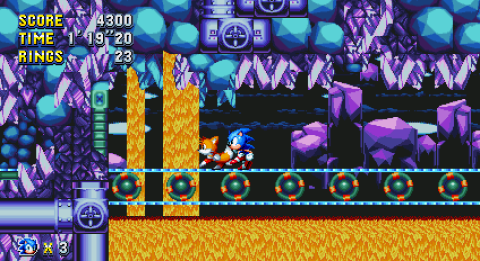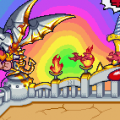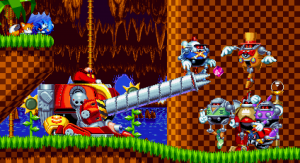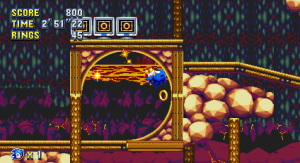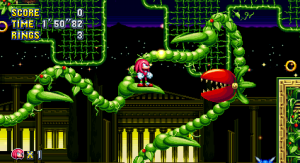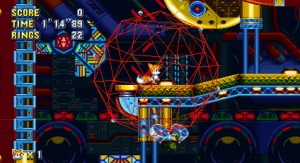- Sonic Generations
- Sonic the Hedgehog
- Sonic the Hedgehog 2
- Sonic CD
- Sonic the Hedgehog 3
- Sonic & Knuckles
- Sonic the Hedgehog 4
- Sonic Mania
- SegaSonic The Hedgehog
- Sonic The Fighters
- Sonic 3D Blast
- Knuckles’ Chaotix
- SegaSonic Bros.
- Sonic the Hedgehog (8-bit)
- Sonic the Hedgehog 2 (8-bit)
- Sonic Chaos
- Sonic the Hedgehog Triple Trouble
- Tails’ Skypatrol
- Tails Adventures
- Sonic Labyrinth
- Sonic Drift
- Sonic Drift 2
- Sonic Blast
- Sonic R
- Murder of Sonic the Hedgehog, The
- Sonic Advance
- Sonic Advance 2
- Sonic Advance 3
- Sonic Rush
- Sonic Rush Adventure
Despite being some of the most popular games in the Genesis, the Sonic the Hedgehog franchise really floundered after the 16-bit era, as Sega didn’t seem to know what to do with him. Outside of assorted spinoffs, the 3D series began with Sonic Adventure on the Dreamcast, and while not all of these are awful, they’re very much different than its Genesis cousins. The 2D series continued on the Game Boy Advance and Nintendo DS, courtesy of subcontracted developer Dimps, though for a variety of reasons, these were never as good either. With the popularity of downloadable games offered by platforms like Steam and the Xbox Live Arcade, Sega looked to the past to create a classic-style game with Sonic the Hedgehog 4, which also missed the mark for a number of reasons. Around the same time, the Sega of America was producing ports of the older Sonic games using the Retro Engine by Christian Whitehead and Headcannon. Eventually, Sega finally gave him and his team the go-ahead to use this engine, originally created for Sonic fan games, to create a new, official Sonic the Hedgehog game. Together with PagodaWest Games, that title, released in 2017, is Sonic Mania.
Sonic Mania looks, sounds, and plays like a classic Sonic title. It isn’t actually a 100% new game, but rather half new material, half “tribute” to the 16-bit games, featuring rearranged takes on classic levels. When you play as Sonic, the game’s opening is right out of Sonic 3, except instead of happening upon Knuckles, you meet Robotnik and his crew of Egg-Robos are digging for something, end up causing a time warp, and sending our heroes back to Green Hill Zone from the original Sonic the Hedgehog. Yet, while it’s very familiar, it’s not quite the same, as it’s much larger, and offers sections where you can go underground and see different parts of the level, sort of like what was seen in Sonic Generations. Indeed, the game takes the Sonic 3 & Knuckles approach to level design, in sticking a boss at the end of the first Act, and giving the second Act some new twists (and remixed theme music). Along with the Egg-Robos (a gang of robots with various skills, themselves based on regular enemies from Sonic & Knuckles), Metal Sonic from Sonic CD also makes another appearance.
The returning levels, outside of Green Hill, are Chemical Plant and Oil Ocean (from Sonic 2), Hydrocity (from Sonic 3), Flying Battery and Lava Reef (from Sonic & Knuckles), and Stardust Speedway and Metallic Madness (from Sonic CD). The first Act of Chemical Plant combines various familiar sections from the both areas of the original game, while the second Act is entirely new, featuring syringes where you can inject new chemicals into pools, changing their colors and giving them elastic properties, allowing Sonic to bounce higher. During the second Act boss fight, it’s revealed that the chemical are also used for making puyo blobs, where you play a quick game of Puyo Puyo…err, Dr. Robotnik’s Mean Bean Machine against the villain. The first Act of Stardust Speedway takes place in the Past variation of the stage, with vegetation overgrowing the ruins, while the second Act takes place in the Present version, where everything looks like musical instruments.
Back in Sonic CD, the Metallic Madness level featured see-saws that didn’t do much of anything – here, they’ll fling you far into the background, which features a whole later of different obstacles, an effect seen in other platforms like Donkey Kong Country Returns and Mutant Mudds. The second act of Oil Ocean borrows some aspects from Sandopolis Act 2 from Sonic & Knuckles, as the level routinely clouds thanks to pollution (which not only blocks your view but also drains your rings), and you need to regularly pull on chains to clear it up. In fact, many of the areas mix and match aspects from levels from other games. Here, Lava Reef features the same fire-spewing robot dinosaurs that were originally found in Hill Top Zone from Sonic 2. Yet even if you spot these elements, they’re usually used in fresh ways, and never feel recycled. The game has the Fire, Bubble, and Lightning shields as found in Sonic 3 & Knuckles, with some interacting with levels in new ways – riding the oil slides in Oil Ocean with the fire shield will cause a satisfying (though thankfully harmless) trail of blazing heat. Obviously, the levels that were already in Sonic 3 & Knuckles don’t benefit as much from these enhancements because the changes and additions aren’t as radical, but the stages themselves are still well done.
The real draw, though, are the four new zones: Studiopolis, Press Garden, Mirage Saloon, and Titanic Monarch. Though there were some exceptions, many of the zones in the original Sonic games stuck to some typical themes: tropical level, water level, metallic level, lava level, and so forth. These areas, however, are far more creative. Studiopolis takes place in a massive television and radio studio, offering tons of unusual gimmicks, like platforms held in motion by film projectors, vans that turn your character into TV/radio waves to be beamed around the level, and even popcorn machines (owing to the popcorn dispensers featuring Sonic found in Japanese arcades back in the 90s). The levels are filled with gigantic monitors (complete with CRT effects) and old-timey cartoons of Dr. Robotnik doing 1930s Disney-style dances. Press Garden is actually a gigantic newspaper press that takes place inside a green-bricked structure, with the second Act being given a snowy makeover reminiscent of Japanese gardens.
Mirage Saloon is based on the scrapped Dust Hill zone from Sonic 2. The developers originally pitched it as a bonus addition to the 2011 port of Sonic CD, but was rejected in favor of keeping the port more faithful, but the idea lives on here. Beyond just being a desert zone, it’s inspired by cowboys and the wild west, featuring gigantic six-shoots that can launch you across the stage, loops made of sand that dissolve once you zoom around them, and water pathways created by seltzer bottles. The levels end with a fight against the magician Egg-Robos, who summons characters based off of Bark, Bean, and Fang from Sonic the Fighters. This is also the only stage where Sonic’s version of the level is completely different from the others – as Sonic, the first Act takes place (mostly) on the biplane, like the Sky Chase Zone from Sonic 2, while the other two characters have a completely different area to explore on foot, which are more attuned to Knuckles and Tails more vertically oriented moveset.
Titanic Monarch is the climactic area, a dark and foreboding city featuring a number of those orbs from the bonus stages of Sonic & Knuckles, where you need to get the timing correct to launch off in the right direction. All four of these levels are incredible, and are easily the richest seen in any Sonic games, or any other 2D platformer out there, really. The only downside is the same issue that affect Sonic 3 & Knuckles – some (especially Titanic Monarch) are too long, and the ten minute time limit is too restrictive, especially when going through the level for the first time.
There are two types of bonus stages in Sonic Mania. When hitting checkpoint posts with enough rings (just 15), you’ll enter the classic Blue Sphere game from Sonic 3 & Knuckles, here reproduced with much smoother scrolling. Beating these isn’t essential to the core game, but they will unlock various features, like the ability to use moves from other Sonic games (the Insta-Shield from Sonic 3, for example, or the peel-out speed dash from Sonic CD). The others are opened by finding hidden rings, like Sonic 3 & Knuckles. These particular stages are similar to the 3D ones from Sonic CD, though they’re presented more as race courses rather than open-ended arenas (though you can still run around in any direction you want). Rather than destroying multiple UFOs, you only need to catch one, though at the outset, they’re much faster than your character. So, you need to grab blue orbs to increase your speed to catch up to it, while gaining rings to increase your timer. These are more manageable than the Sonic CD stages, though they have their quirks – it’s very easy to fall out of the stage and lose immediately! As with Sonic 3 & Knuckles, you need to collect all of the Chaos Emeralds in order to unlock the final battle, called Egg Reverie, along with the true ending.
The levels are filled with all kinds of references, relating to both Sonic and other Sega titles, as well as in-jokes for the Sonic fan community. The “Pink Bot” signs in Studiopolis recall the “Pink Pot” diner from the first level of Streets of Rage; the vans with the satellites read “Hornet High Class”, a reference to Daytona USA, and announcer Takenobu Misuyoshia even shows up to read off the lottery results. The same level includes references to the “Genesis Does What Nintendon’t” and “To Be This Good Takes Ages” advertising slogans used in North America and the United Kingdom, respectively. If you look closely at the constellations in Stardust Speedway, you can spot the weird guy from the embarrassingly bad cover on the Genesis cover of Columns III. Some of these get really obscure – buried in the code of the original Sonic the Hedgehog but unused were goggles, which people presumed would allow Sonic to breathe underwater. Here, you can see Sonic wearing these same goggles as he pilots the biplane if you begin the game as Tails. There’s also an unused enemy that was featured in marketing material but never used, a bunny called Splats, which makes an appearance here. One of the enemies found in the Lava Reef Zone boss fight is named Jimmy, after Cody “Polygon Jim” Lawrence, a member of the Sonic ROM hacking community who passed away in 2013. In one spot of Studiopolis, you can hear some obnoxious buzzing, a reference to a Sonic the Hedgehog livestream event held in 2016, which was plagued with technical issues, including that very same buzzing. And owing to a popular meme of sticking “& Knuckles” onto everything, there’s a mode where you can play as two Knuckles called (yup) Knuckles & Knuckles. (Of all of the weird gaming culture jokes, this one was also referenced in Deus Ex: Mankind Divided, of all places.)
At first, Sonic Mania looks like a 16-bit title, just displayed in widescreen. But the game actually uses more colors than the Genesis was capable of, which is especially noticeable in the new levels, plus there are various rotation and scaling effects that wouldn’t have been possible on the system. It actually positions itself more like a theoretical Saturn game would have look like – even in the few instances it uses 3D, it intentionally uses low polygon models. Since all of the mainline Genesis games featured redrawn Sonic sprites, this one does too – it’s mostly based on his sprite in the first game, though with a brighter coloring similar to the later games. The animated introduction recalls the Sonic CD video scenes, though much more colorful, as the heroes run around in environments similar to the Japanese box arts of the 16-bit games.
All of the tracks carried forward from the older games sound remarkably faithful, with slightly upgraded synth that manages to maintain the same texture as the classic tunes while still sounding cleaner than before. The second Act arrangements, where appropriate, are excellent too, as are the new boss themes. For the Sonic CD levels, it uses the Japanese soundtrack as its base, though it would’ve been nice to hear some takes on the American soundtrack. The themes for the new levels are all fantastic too, with a fresh style that still keeps consistent with the Sonic feel. The soundtrack was composed by Tee Lopes, marking his professional debut after creating remixes of other classic video game music as a hobby.
The few issues with the game are the same found in the rest of the classic Sonic games – there are still some cheap deaths, as well as occasionally frustrating bugs. Running out of lives will also force you back to the beginning of the Act, which is the same system as Sonic 3 & Knuckles, though those who aren’t accustomed to these kind of harsh checkpoints may be frustrated (though it’s not as punishing as it was in the first two games, where you could lose the entire game if you didn’t have any continues).
While some in the retro game community continue to sneer at “fan” developed games, Sonic Mania is definitely one of the cases where the longtime fans have a much greater grasp on the heart of the franchise than the actual developers. It shows Sonic as its best, mostly avoiding its weaker aspects, filling it with fan service for longtime fans while still making it approachable to newcomers. It’s not only the best 2D Sonic game but one of the best retro revivals around.







